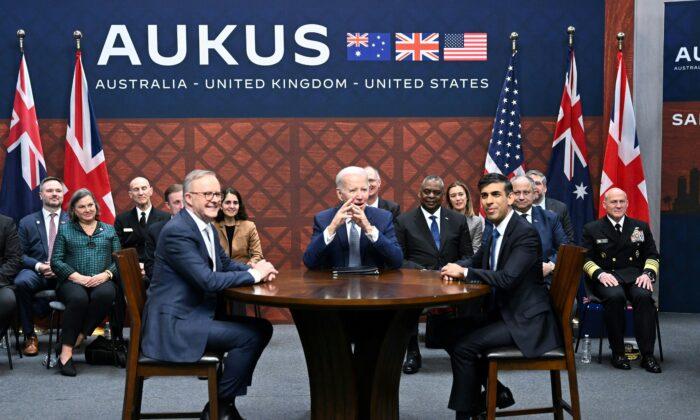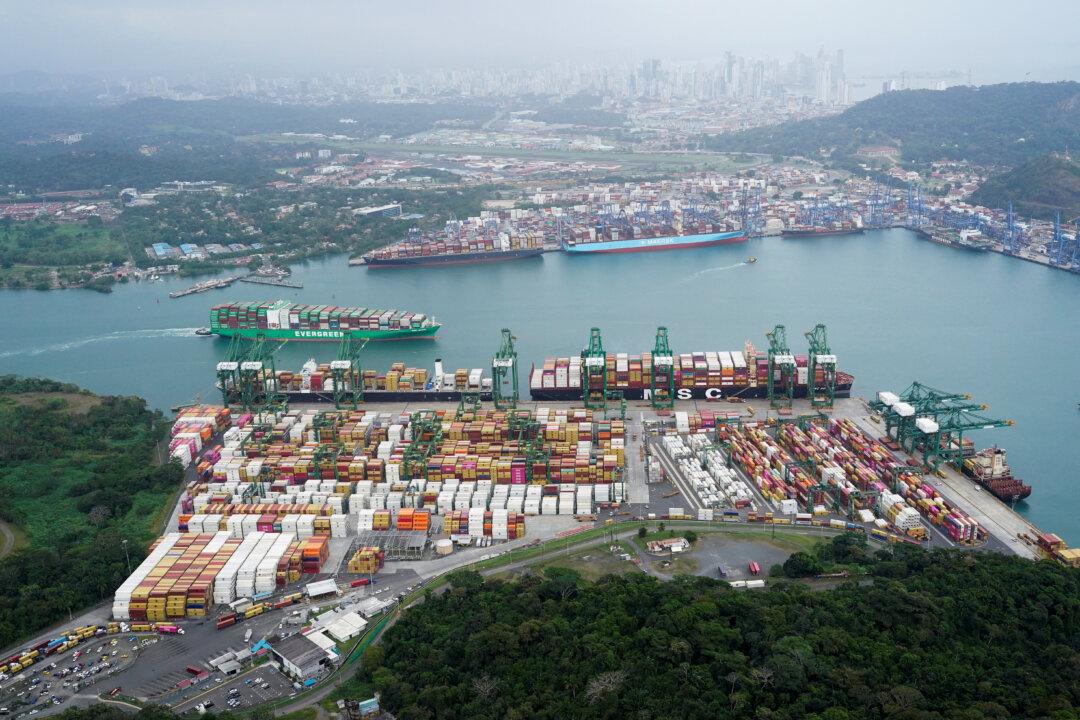The most significant strategic alliance created since the end of the Cold War—the Australia-United Kingdom-United States (AUKUS) security pact—is considering adding Japan to the framework. At the same time, the alliance’s initial pillar increasingly seems destined to fail.
What this means is that Australia’s nuclear attack submarine program is likely to be significantly constrained.
The foundation pillar of AUKUS, the reason the pact was created, was to facilitate the acquisition of technology to allow Australia to build its own nuclear-powered attack submarines (SSNs).
Meanwhile, having begun that initial stage, the alliance is now working on “Pillar Two” of its framework: transferring other strategically significant technologies between the member states. Pillar Two is working well, with significant benefits to the United States, the UK, and Australia. The Royal Australian Navy (RAN) personnel are now training in the United Kingdom and the United States on nuclear submarine operations as part of Pillar One, and engineers from Australia are working with their UK and U.S. counterparts. However, all the very expensive work on the technology transfer process cannot cover the flaws in the initial vision.
Put simply, there is no strategy behind the process. There are plans, but nothing that takes into account the broader global strategic framework that will govern the threat and opportunity contexts that will apply to Australia and its alliance partners in the program’s 70-year-plus timeframe. Neither is the program being considered in light of the imbalance it must inevitably bring to the Australian defense budget.
Australia’s defense white papers and reports, including the most recent study released in February titled “Enhanced Lethality Surface Combatant Fleet: Independent Analysis of Navy’s Surface Combatant Fleet,” do not rise to the level of national-level strategy thinking or “grand strategy.” Subsequent Australian governments of the major parties themselves have issued no grand strategy-level guidance.
It was in this framework that the Australian government and the RAN pivoted to the nuclear submarine option when its earlier plans to build a new, blue-water conventional submarine—which politically, ultimately, and belatedly centered around an unproven French pump-jet propulsion design, the Shortfin Barracuda (later renamed the Attack-class)—collapsed and was canceled on Sept. 16, 2021, after an expenditure of many billions of dollars and considerable wasted time.
This is not to deny the fact that SSN capabilities could be of great strategic value to Australia if they were available in the short term. But Australia is looking at the current and immediate future threat environment, essentially from communist China, and should have considered SSNs decades ago. After all, the first SSN was delivered to the U.S. Navy (SSN-571, USS Nautilus) 70 years ago this year, not long after Australia participated with the United States, UK, and Canada in the World War II nuclear programs.
What is significant is that the Australian government and the RAN want to have the firepower and prestige of a nuclear attack submarine capability but without a commensurate national strategy of where Australia wishes to position itself for security and growth.
Australia, under Pillar One of AUKUS, has committed to the purchase of three to five U.S. Virginia-class SSNs (an initial three, followed by an option for two more) and the acquisition from the UK of five SSN-AUKUS type SSNs (being referred to now as SSN-A in the UK) being developed as a follow-on to the Royal Navy’s Astute-class SSNs. Two of the RAN’s vessels would be built in the UK, with Australia then building three follow-on vessels in South Australia.
- Australia would not commission its first SSN-AUKUS submarines until the 2040s. The UK government has not yet determined the cost of the SSN-AUKUS, so any cost projections for Australia are very loose estimates and must take into account that Australian-built naval vessels have historically cost as much as four times the cost of vessels built in the UK (for example, Australia’s ANZAC frigates, half the size of Britain’s Type 23 frigates, cost twice as much to build as the Type 23).
- Australia would likely acquire its first ex-U.S. Navy Virginia-class SSN in the “early 2030s” while committing some or all of the RAN’s existing Collins-class SS boats (diesel-electric powered) to an extensive service life extension program (SLEP). The first Virginia-class boats for the RAN would be ex-U.S. Navy and, therefore, well into their planned 38-year lifespan at the time of their initial deliveries (2032 and 2035). The first newly-built Virginia for the RAN would not be delivered until 2038, and that delivery date is by no means certain. Even with this plan, the U.S. defense industrial base is unsure that it can deliver the extra vessels to the U.S. Navy (to compensate for the sale of existing vessels) and to the RAN without jeopardizing the U.S. Navy’s requirements for its fleet.
- The Chinese regime, the ostensible cause for Australia’s need for SSNs, is likely to peak and decline as a strategic threat to Australia and the West well before delivering the first SSNs to Australia from the United States or the UK. China’s decline is based on the economic implosion already evident in the country as of 2024. So either the Chinese Communist Party (CCP) would attempt a military challenge to the West (via a Taiwan initiative) before Australia has its long-range SSNs ready, or it will implode or recede as a strategic military threat.
- The prospect for follow-on threats or pacing challenges for the RAN and the Australian Defense Force after the collapse or duration of the Chinese threat must be assumed to include Russia, India, and Indonesia. It is not inconceivable that other threats could emerge in the timeframe in question (say, from 2030 onwards). However, while long-range, long-duration capabilities such as those offered by SSNs may retain value in the out-years, the question will be whether that value is cost-effective, especially bearing in mind the development of new, large, and capable unmanned underwater strike vehicles (already underway in Australia, the UK, and the United States, as well as elsewhere), and new anti-submarine countermeasures. The RAN’s SSN plans seem predicated on a stasis in submarine/ASW capabilities going forward or merely anticipating evolutionary capabilities in the countermeasure balance. In other words, Australia is committing to a finite capability going forward into the unknown future when the threat and technology environment will be anything but fixed.
- Australia has a current defense budget of some $34.22 billion (AU$ 52,558.8 million for 2023–24). The cost of the SSN program for Australia, including the newly built work in the country on the SSN-AUKUS, is estimated to be in the vicinity of $240 billion (AU $368 billion), or, say (in crude accounting terms), $8 billion a year over the coming three decades. Full life-cycle costs for the SSN program are expected to cost some AU$1 trillion ($650 billion) or more. And that assumes that the anticipated creep in the budget does not occur.

That does not include absorbing the billions lost with the French program), and may well be a minimum level of cost. However, no one, including the Australian government, has a full grasp of the future costs of the SSN project. And given the current challenges for the Australian Defense Force and the costs of doubling the surface combatant fleet (now underway), the strain on the defense budget may be intolerable, especially considering that defense spending suffers as governments in Australia typically retract their promises in favor of social programs. Current defense spending is estimated at 2.04 percent of GDP. Again, we are looking at seeing budget-distorting expenditure levels in a future in which the threat environment is likely to change substantially.
Moreover, the process envisages sustained linear growth in the Australian economy, something that cannot be taken for granted given global economic trends, the continued distortion of the Australian economy, and declining productivity.
- A consistent and absolute refusal of any Australian government for the past 124 years to undertake a grand strategy assessment of the nation’s needs except for the one overriding consideration that Australian governments follow their dominant partner: the UK until 1942 and the United States thereafter. And although Australia is meant to be an equal partner in its main strategic treaties (AUKUS, ANZUS, etc.), it has always preferred to view Australia’s threat and options through the lenses of its major partners. Australia has never accepted a strategic perspective by which it takes a leadership role, even within its own geostrategic zone.
- The now-evident reality that the strategic threat from the CCP, while transforming through its evolving process of “new total war” doctrine, is in many respects diminishing (although remaining potent), largely because of the collapse of the Chinese economy. This is coupled with growing evidence of disharmony between the People’s Liberation Army (PLA) and the now-isolated Xi Jinping leadership, as well as the growing evidence of major technological and operational shortcomings in the PLA.
The prospect of a sea change in China in the near term (even as early as 2024) must be considered, with either the CCP removing or isolating Xi or the CCP itself facing an insurmountable public rejection. - Whatever variations may be feasible within the Chinese situation, the prospect of a major war between China and its neighbors, plus the United States and its allies (including Australia), has diminished considerably in the past few years, inversely proportionate to the rise in CCP/Xi bombast (“wolf-warrior” diplomacy and military gestures short of kinetics).
A significant conflict remains possible but less probable, but if it comes to that point, it will likely be sooner rather than later. This means the Australian SSN program would emerge into an entirely new strategic era and framework in which different technological and military options would prevail. - The prospect exists that if the CCP threat peaks and then troughs within the coming few years, then the United States will be under less pressure to maintain its projection into the Indo-Pacific region unless it is to counter a resurgent Russia (through the Russian Far East via Vladivostok, or through the Indian Ocean as a result of the Moscow-dominated International North-South Transport Corridor: INSTC). The INSTC links Moscow closely with India, which may make the Washington–New Delhi relationship more restrained than the United States would presently like.
- New technologies, heavily geared around artificial intelligence and quantum computing, enable new unmanned systems to dominate a foreseeable generation of underwater and airborne military capabilities, transforming the need for SSNs. Pillar Two of AUKUS is certainly about that reality. Even if SSNs provide a highly desirable global roaming/power projection capability, the question becomes whether they are viable in an Australian cost-benefit scenario.
Moreover, nuclear-powered (and therefore relatively large) submarines are not suited to all environments. Australia’s and Sweden’s conventional submarines have already demonstrated capabilities to evade present U.S. anti-submarine measures, and they are also better suited than nukes to shallow waters, such as those around Australia’s northern reaches. SSNs versus SSKs is not the argument; each has a different, complementary task to fulfill. - The UK’s Astute-class SSNs are not proving to be trouble-free, and, likely, the SSN-AUKUS will also have teething problems, just as the conventional (SSK) Collins-class boats had for the RAN. However, at the bottom line, the steps taken by Australia for the Virginia-class SSNs will, in fact, tie Australia to the U.S. supply chain for at least the next three decades or more. While that may be seen as desirable by some, it also postpones the necessity for Australia to “leave the nest” and evolve its own leadership position in the greater Oceania region (the Southwest Pacific over to the Indian Ocean).
The bottom line assessment must be that some aspects of the Australian nuclear submarine program will fall by the wayside. The RAN may probably acquire some used Virginia-class SSNs from the U.S. Navy, much like the Indian Navy muddled through leases with former Soviet SSNs. It seems likely that the purchase of follow-on (newly built) Virginias may be scrapped and that the purchase of UK-built SSN-AUKUS boats may also fail to materialize.
On an extremely positive level for the country, despite the initial claims by the Australian prime minister of the time, Scott Morrison (Liberal Party), that the acquisition of nuclear-powered submarines would not lead to the creation of an onshore civil nuclear power industry, the reality was that the “nuclear barrier” was broken in Australia, and discussion of civil nuclear power has received widespread public enthusiasm.

Even before the Federation in 1901, Australia had its military operating abroad (from the Boxer Rebellion to the Boer War and Sudan), and it operated with its ground forces, navy, and air force globally in every major 20th-century conflict. It was able to do so before the advent of nuclear-powered submarines and can continue in that tradition, with or without nuclear-powered vessels. Nuclear-powered vessels would be a desirable enhancement for the RAN, but work on this should have begun after World War II, as it did with the UK, the United States, and the Soviet Union. Australia’s entry into the field of nuclear engineering is belated but necessary, but it may not be able to save Australia’s immediate submarine dilemma at this stage.
More significantly, the Australian government has, particularly in the post-World War II era, dominated the defense industrial capacity of the nation, essentially destroying the innovative and cost-effective private sector capability to build complete platforms and invent new systems. It forced the breakup and sale of Australia’s defense industrial base to support its subordination into major U.S., UK, and European defense companies, unnecessarily denying Australians control over their national security base. The Australian Defense Force has been complicit in this, preferring the acquisition of foreign options, with all the implicit strategic dependency that this creates.
Costs of Australian defense procurement, then, have reached disproportionately high levels, rationalized away by statements such as “Australian wages are higher than elsewhere in the world,” implying that U.S., British, German, Swedish, and Japanese workers are somehow paid 10 times less than Australians. It is true that, despite labor-saving computing and the like, Australia (like the United States and Europe) has seen a progressive decline in per capita productivity over the past decade.
In many respects, Australia is at a pivotal point in its history, but it seems that it has not grasped this reality.







